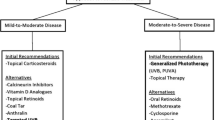Abstract
Introduction
We conducted a phase IV randomized, double-blind, placebo-controlled, pilot clinical trial to investigate the safety and efficacy of oral curcumin together with local phototherapy in patients with plaque psoriasis.
Materials and methods
Patients with moderate to severe psoriasis received Curcuma extract orally with real visible light phototherapy (VLRT) or simulated visible light phototherapy (VLST) in the experimental area, while the rest of the body surface was treated with ultraviolet A (UVA) radiation. The endpoints were the number of responders and the temporal course of the response. The secondary outcomes were related to safety and adverse events.
Results
Twenty-one patients were included in the study. In the intention-to-treat analysis, no patients included in the VLRT group showed “moderate” or “severe” plaques after the treatment, in contrast to the patients included in the VSLT group (p<0.01). Parallelisms in the evolution of PGA, BSA, and PASI scores were observed in the two groups following the treatment. At the end of the study period, 76% of all patients showed a response in the BSA exposed to UVA. Lesions on the experimental area showed a response in 81% of the patients in the VLRT group and 30% of the patients in the VLST group. There were no study-related adverse events that necessitated participant withdrawal.
Conclusion
The results suggested that moderate to severe plaque psoriasis should showa therapeutic response to orally administered Curcuma if activated with visible light phototherapy, a new therapeutic method that would be safer for patients than existing treatments.
Similar content being viewed by others
Abbreviations
- PUVA:
-
Psoralen associated with Ultraviolet A radiation
- UV:
-
Ultraviolet radiation
- UVA:
-
Ultraviolet A radiation
- UVB:
-
Ultraviolet B radiation
- VLRT:
-
Visible light real treatment
- VLST:
-
Visible light simulated treatment
- BSA:
-
Body Surface Area Affected
- PGA:
-
Physician Global Assessment
- PASI:
-
Psoriasis Area Severity Index
References
Lázaro P, Suárez R. Actualización en el tratamiento de la psoriasis. Inf Ter Sist Nac Salud 2001; 25: 105–10.
Stern RS. Psoralen and ultraviolet a light therapy for psoriasis. N Engl J Med 2007; 357: 682–90.
Menter AB, Gottlieb A, Feldman SR, et al. Guidelines of care for the management of psoriasis and psoriatic arthritis: Section 1. Overview of psoriasis and guidelines of care for the treatment of psoriasis with biologics. J Am Acad Dermatol 2008; 58: 826–50.
Thangapazham RL, Sharma A, Maheshwari RK. Beneficial role of curcumin in skin diseases. Adv Exp Med Biol 2007; 595: 343–57.
Dujic J, Kippenberg S, Hoffmann S, et al. Low concentrations of curcumin induce growth arrest and apoptosis in skin keratinocytes only in combination with UVA or visible light. J Invest Dermatol 2007; 127: 1992–2000.
Dujic J, Kippenberger S, Ramirez-Bosca A, et al. Curcumin in combination with visible light inhibits tumor growth in a xenograft tumor model. Int J Cancer 2009; 124: 1422–8.
Miquel J, Bernd A, Sempere JM, Díaz-Alperi J, Ramírez-Boscá A. The Curcuma antioxidants: pharmacological effects and prospects for future clinical use. Arch Gerontol Geriatr 2002; 34: 34–46.
Bernd A, Theilig C, Kippenberg S, et al. An extract of Curcuma longa exerts antioxidative, antiinflamatory and antiproliferative effects on human keratinocytes in vitro. J Invest Dermatol 1997; 109: 460.
Bernd A, Theilig C, Kippenberg S, et al. Effects of Curcuma longa extract on the expression of proinflammatory citokines. Skin Pharmacol Apll Skin Physiol 2000; 13: 226.
Asín-LLorca M, Ramírez-Boscá A, Miquel J, et al. Ensayo clínico piloto no controlado de eficacia de 600 mg/día de Extracto de Curcuma estandarizado al 12% en curcumina en el tratamiento de pacientes con psoriasis crónica en placas moderada-grave. 2006; EUDRACT N° 2006-003395-35.
Kurd SK, Smith N, Voorhees AV, et al. Oral curcumin in the treatment of moderate to severe psoriasis vulgaris: A prospective clinical trial. J Am Acad Dermatol 2008; 58: 625–31.
Tope WD, Shaffer JJ. Photodynamic treatment; in Bolognia JL, Jorizzo JL, Rapini RP (eds): Dermatology Elsevier, 2005.
Guideline on clinical investigation on medical products indicated for the treatment of psoriasis. [Internet]. CHMP/EWP/2454/02 2011 Mar 8; Available from: www.tga.gov.au/docs/pdf/euguide/ewp/245402en.pdf.
Henseler T, Wolff K, Honigsmann H, Christopher E. The European PUVA study: A cooperative study among 18 european centres. Lancet 1981; 1: 853–7.
Sivanesan SP, Gattu S, Hong J, et al. Randomized, double-blind, placebo-controlled evaluation of the efficacy of oral psoralen plus ultraviolet A for the treatment of plaque-type psoriasis using the Psoriasis Area Severity Index score (improvement of 75% or greater) at 12 weeks. J Am Acad Dermatol 2009; 65: 793–8.
Lin JK, Pan MH, Lin-Shiau SY. Recent studies on the biofunctions and biotransformations of curcumin. Biofactors 2000; 10: 153–8.
Mashewari RK, Singh AK, Gaddipati J, Srimal RC. Multiple biological activities of curcumin: a short review. Life Sci 2006; 7: 2081–7.
Sikora E, Bielak-Zmijewska A, Magalska A, et al. Curcumin induces caspase-3-dependent apoptotic pathway but inhibits DNA fragmentation factor 40/caspase activated DNA endonuclease in human Jurkat cells. Mol Cancer Ther 2006; 52: 927–34.
Author information
Authors and Affiliations
Corresponding author
About this article
Cite this article
Carrion-Gutierrez, M., Ramirez-Bosca, A., Navarro-Lopez, V. et al. Effects of Curcuma extract and visible light on adults with plaque psoriasis. Eur J Dermatol 25, 240–246 (2015). https://doi.org/10.1684/ejd.2015.2584
Accepted:
Published:
Issue Date:
DOI: https://doi.org/10.1684/ejd.2015.2584




